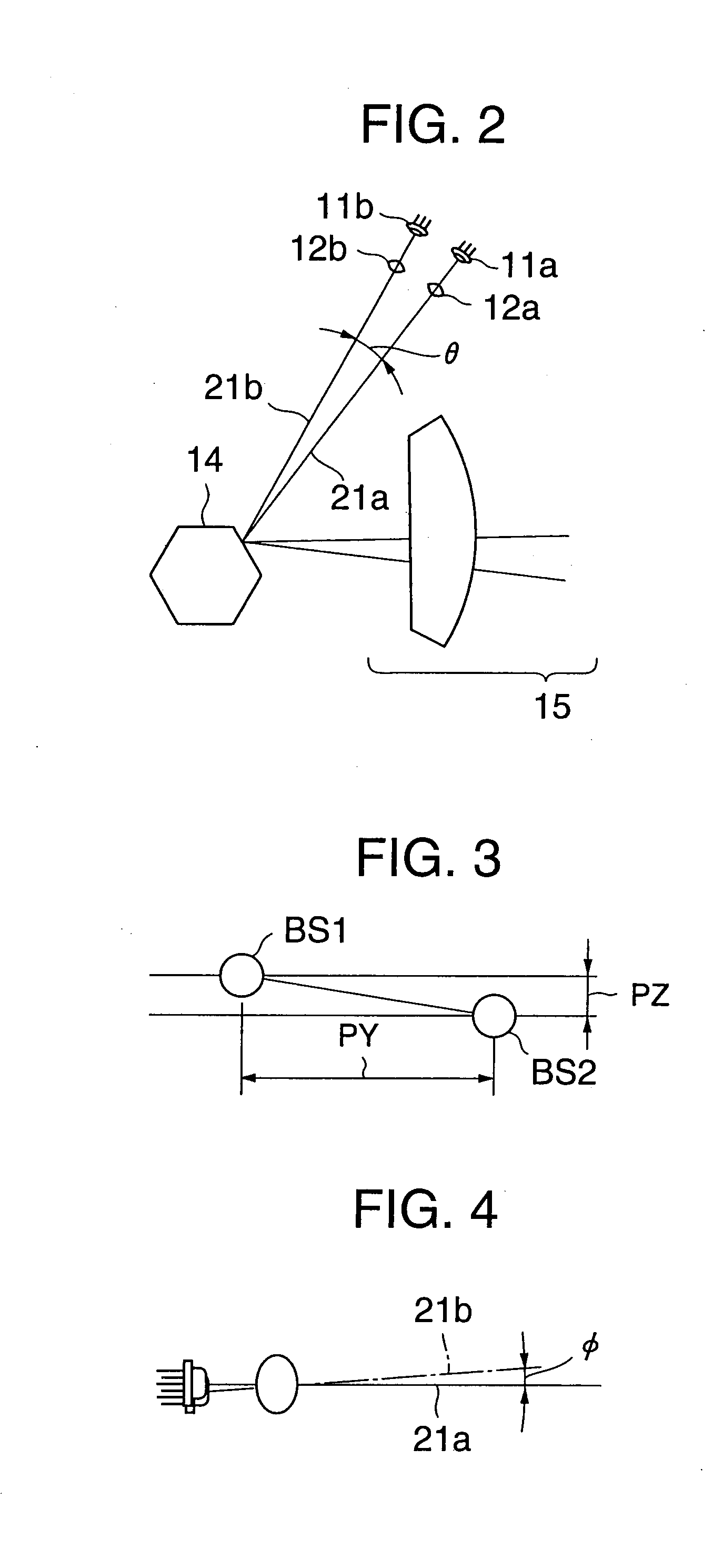Optical scanning apparatus, illuminant apparatus and image forming apparatus
a technology of optical scanning and illumination, applied in the field of optical scanning apparatus, can solve the problems of limited improvement in recording speed, difficult to increase the number of illuminant channels in fabrication, and difficult to eliminate influences on thermal/electronic crosstalk and realize a short wavelength with respect to the semiconductor laser array
- Summary
- Abstract
- Description
- Claims
- Application Information
AI Technical Summary
Benefits of technology
Problems solved by technology
Method used
Image
Examples
first embodiment
[0184]FIG. 1 is a perspective view of an optical scanning apparatus according to the
[0185]In FIG. 1, an illuminant apparatus 18 comprises at least two pairs of a semiconductor laser 11a and a coupling lens 12a and a semiconductor laser 11b and a coupling lens 12b. However, the illuminant apparatus 18 is not limited to this configuration. Also, the semiconductor lasers 11a and 11b may be single beam semiconductor lasers each of which has a single illuminant point or may be multi-beam semiconductor lasers (semiconductor laser arrays) each of which has a plurality of illuminant points.
[0186]The semiconductor lasers 11a and 11b emit laser light. The coupling lenses 12a and 12b couple the emitted laser light, and the coupled laser light results in two resulting optical beams (laser beams) 21a and 21b.
[0187]The optical beams 21a and 21b are shaped into the linear form by a cylindrical lens 13, and the linear optical beams are projected on a deflecting reflection surface of a polygon mirr...
fourth embodiment
[0390]FIG. 39 is a perspective view of an optical scanning apparatus according to the Here, the optical scanning apparatus is formed of a 2-beam scanning apparatus for scanning a surface to be scanned by simultaneously using two optical beams. However, the optical scanning apparatus may be formed of a multi-beam scanning apparatus using more than 2 beams.
[0391]Two semiconductor lasers 11a and 11b emit laser light. Two coupling lenses 112a and 112b couple the emitted laser light, and the coupled laser light results in two optical beams 121a and 121b. The optical beams 121a and 121b are shaped into a linear form by a cylindrical lens 113, and the linear optical beam is projected on a deflecting reflection surface of a polygon mirror 114, which serves as a deflector, in order to produce an optical beam that is focused on the subscanning direction and is linearly formed with respect to the main scanning direction. Then, the deflected linear optical beam is projected to an optical scann...
PUM
 Login to View More
Login to View More Abstract
Description
Claims
Application Information
 Login to View More
Login to View More - R&D
- Intellectual Property
- Life Sciences
- Materials
- Tech Scout
- Unparalleled Data Quality
- Higher Quality Content
- 60% Fewer Hallucinations
Browse by: Latest US Patents, China's latest patents, Technical Efficacy Thesaurus, Application Domain, Technology Topic, Popular Technical Reports.
© 2025 PatSnap. All rights reserved.Legal|Privacy policy|Modern Slavery Act Transparency Statement|Sitemap|About US| Contact US: help@patsnap.com



